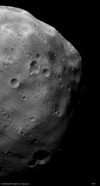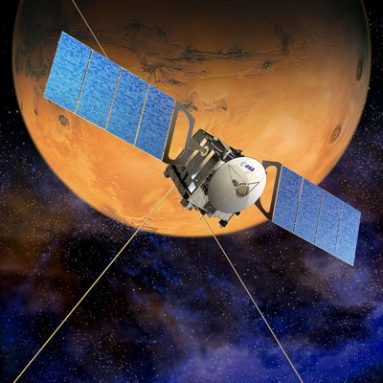Holes in Martian moon mystery
Phobos may be lots of empty space.
By Stephen Ornes
The Martian moon Phobos is cratered, lumpy and about 16.8 miles long, or 3 miles longer than the island of Manhattan. According to a recent study, the moon is also unusually light. Planetary scientists found that Phobos is probably not a solid object, and that as much as 30 percent of the moon’s interior may be empty space.
 |
|
The spacecraft Mars Express snapped this photo of the Martian moon Phobos on March 7.
|
| European Space Agency, DLR/FU Berlin (G. Neukum) |
That doesn’t mean that Phobos is an empty shell where we could, say, set up a rest stop for spaceships on their way to the outer planets. But the new finding probably does mean that Phobos was not an asteroid that got caught in Mars’ gravity as it floated by the planet.
Phobos is the larger of Mars’ two moons, and astronomers have had many ideas about where it came from. Previous studies have suggested that Phobos was an asteroid. Other studies suggest the moon formed from bits of Martian rock that were sent into space after a giant object, like an asteroid, crashed in Mars. The new study suggests that neither of these ideas is completely correct. The truth might be some combination of the two.
Scientists may never know how Phobos came to be a Martian satellite, but the new study may help eliminate some possibilities, Tom Andert told Science News. Andert, who worked on the new study, is a planetary geophysicist at the University of the German Armed Forces in Munich. A planetary geophysicist is a scientist who studies physical properties, such as rocks and appearance, to understand more about celestial bodies such as planets and moons.
 |
|
Mars Express (illustrated here) has been orbiting Mars and collecting data about the planet since 2003. The way Phobos pulled at Mars Express provided information about the moon’s mass.
|
| European Space Agency, D. Ducros |
Andert and his colleagues were able to study Phobos thanks to the Mars Express, a spacecraft that orbits Mars and takes measurements. That spacecraft left Earth in 2003 and is a project by the European Space Agency, or ESA. In March, Mars Express flew closer to Phobos than any spacecraft ever had before, ESA reports.
The scientists wanted to learn the density of Phobos. Density measures how close together, on average, are the atoms in an object. If two objects are the same size but have different densities, the denser object will have more mass — which means it will feel heavier when you’re holding it on Earth. Density is found by dividing mass by volume. Since the scientists already had a good idea of the volume of Phobos, they just had to find its mass in order to figure out its density.
They made their mass measurements by studying the gravitational force of Phobos. Gravity is an attractive force, which means anything with mass attracts anything else with mass. (A human body, for example, gravitationally attracts every other human body. Earth attracts those human bodies to it even more.) The more mass an object has, the stronger its gravitational force. Since a large body like the Earth has a lot of mass, it has a strong gravitational force — strong enough to hold people on its surface and the Moon in orbit.
When Mars Express flew close to Phobos, the small moon’s gravity attracted the spacecraft. By studying changes in the motion of Mars Express, the scientists were able to estimate the gravitational tug of Phobos. Once they knew the strength of its gravity, they could find its mass.
They found that Phobos has a density of about 1.87 grams per cubic centimeter. The rocks in the crust of Mars, for comparison, are much denser: about 3 grams per cubic centimeter. This difference suggests that Phobos is not made of rocks from the surface of Mars.
Some asteroids have densities of about 1.87 grams per cubic centimeter, but Andert says that those asteroids would be broken apart by Mars’ gravity — a fact that probably rules out the possibility that Phobos was once a free-floating asteroid.
Some scientists, like Tom Duxbury, don’t mind giving up the idea that Phobos was once an asteroid. “Finally we’re drifting away from the idea that the Martian moons are captured asteroids,” Duxbury told Science News. Duxbury, of George Mason University in Fairfax, Va., did not work on the new study but also studies planets. He told Science News that he’s “happy to see that Phobos and Deimos [Mars’ other moon] are getting a lot of attention these days.”
POWER WORDS (adapted from the Yahoo! Kids Dictionary)
gravity The natural force of attraction between any two massive bodies. It is directly proportional to the product of the objects’ masses and inversely proportional to the square of the distance between them.
moon A natural satellite revolving around a planet.
orbit The path of a celestial body or an artificial satellite as it revolves around another body. For example, the path of a planet as it moves around its host star.
planetary geophysics The physics of planets and their environments, including the field that combines physics and geology.
Going Deeper:
Perkins, Sid. 2010. “Martian moon probably pretty porous,” Science News, June 5. http://www.sciencenews.org/view/generic/id/59214/title/Martian_moon_probably_pretty_porous
Ornes, Stephen. 2010. “Planning for Mars,” Science News for Kids, May 5. http://www.sciencenewsforkids.org/articles/20100505/Note1.asp
Savage, Liz. 2009. “Either Martians or Mars has gas,” Science News for Kids, February 18. http://www.sciencenewsforkids.org/articles/20090218/Note2.asp







